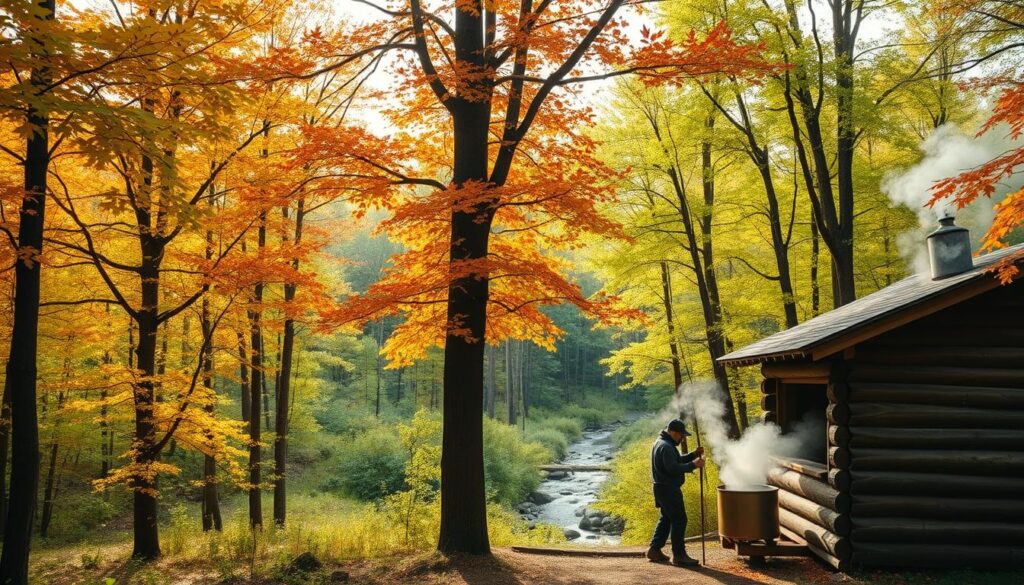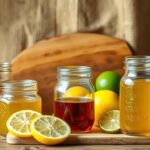Maple syrup is more than just a tasty breakfast topping. It’s a blend of human ingenuity and nature’s care. The sustainable maple industry values forests and traditional methods deeply.
In North America’s green forests, sugarmakers tap maple trees with care. They make sure each tap helps the tree and the forest. This way, the trees keep giving sap for years, helping both people and nature.
Maple syrup making needs a lot of care for the environment. Sugarmakers pick the right spots to tap and use exact methods to get the sap. This keeps the forest healthy and the syrup flowing.
Today’s maple syrup makers do more than just tap trees. They also protect forests, cut down on carbon, and keep the ecosystem balanced. Their work shows how maple syrup can be good for the planet.
As more people want natural, eco-friendly sweeteners, maple syrup is leading the way. By saving forests, using new tech, and keeping old traditions alive, these experts make sure we can all enjoy maple syrup for years to come.
Understanding Traditional Maple Syrup Production Methods
Maple syrup production links human culture with nature. It uses ancient wisdom and green practices. These methods honor the environment and keep traditional knowledge alive.
Indigenous Harvesting Techniques
Native American tribes started maple syrup practices long before Europeans came. They chose the right maple trees and used smart ways to get sap. This was done with little harm to nature.
- Birch bark containers for sap collection
- Stone tools for tree tapping
- Slow-boiling methods using heated stones
Evolution of Maple Tapping Methods
Maple syrup making has changed a lot over time. Old ways were replaced by new, better methods. These new ways are both efficient and kind to the environment.
| Era | Tapping Technique | Environmental Impact |
|---|---|---|
| Pre-Colonial | Manual bark tapping | Minimal disruption |
| 19th Century | Metal spouts and buckets | Moderate forest interaction |
| Modern Day | Vacuum tube systems | Reduced tree stress |
Cultural Significance in North America
Maple syrup is more than food; it’s a cultural story. It connects Indigenous people, early settlers, and today’s farmers. The maple tree stands for strength, food, and caring for resources.
“Maple syrup is not just a product, but a testament to harmonious human-nature interaction.” – Indigenous Maple Harvesting Elder
The Environmental Impact of Modern Maple Syrup Production
Maple syrup production is a special mix of farming and forest care. It shows us how to manage resources in a green way. This goes beyond just making sugar.
Sugarmakers are key in keeping forests healthy while making maple syrup. They use careful forest management and protect nature.
- Forest preservation through selective tapping
- Minimal invasive harvesting techniques
- Protection of maple tree health
- Sustainable woodland management practices
The environmental effect of making maple syrup changes with the size of the operation. Small producers usually have greener methods than big ones.
| Production Scale | Environmental Impact | Sustainability Rating |
|---|---|---|
| Small Family Farms | Low Carbon Footprint | High |
| Medium Operations | Moderate Carbon Footprint | Medium |
| Large Industrial Production | Significant Carbon Footprint | Low |
Good maple syrup makers know that healthy forests mean better syrup and a greener future. They use green strategies to keep maple forests alive for the next generations.
“Sustainable maple production is about protecting our natural resources while creating a delicious product,” says a leading forest conservation expert.
Maple Syrup Sustainable Practices: A Guide
Producing maple syrup in a sustainable way is key to keeping our natural world healthy. It also helps keep the syrup quality high. Eco-friendly practices in maple syrup production are now more important than ever. They help reduce harm to the environment and protect our forests.
To make maple syrup sustainably, we need a balanced approach. This means taking care of the environment and making money at the same time. Maple syrup makers are finding new ways to keep forests healthy and improve how they make syrup.
Forest Management Strategies
Good forest management is essential for healthy maple groves. Here are some important strategies:
- Selective tree tapping to prevent forest damage
- Maintaining diverse forest ecosystems
- Implementing rotation systems for maple tree recovery
- Monitoring tree health and growth patterns
Resource Conservation Techniques
Maple syrup eco-friendly practices aim to use less resources. They use smart methods to do this:
| Conservation Method | Environmental Impact |
|---|---|
| Efficient water management | Reduces water waste by 40% |
| Solar-powered processing | Decreases carbon emissions |
| Thermal energy recycling | Minimizes energy consumption |
Waste Reduction Methods
Today’s maple syrup makers turn waste into something useful. They use creative ways to do this:
- Repurposing wood waste for biomass energy
- Converting maple processing byproducts into fertilizers
- Developing secondary product lines from maple residues
These sustainable practices show the maple syrup industry’s dedication to caring for the environment and making products responsibly.
Organic Certification Standards in Maple Syrup Production
The sustainable maple industry values organic certification highly. It ensures organic maple syrup quality. This certification proves that production is environmentally friendly, protecting forests and maple trees.
Producers of organic maple syrup must follow strict rules. These rules are set by government agencies. They cover important areas like:
- No synthetic pesticides or chemical fertilizers in forest management
- Sustainable forest conservation practices
- Minimal environmental impact during harvesting
- Transparent documentation of production processes
The certification process checks maple syrup production closely. Inspectors look at:
| Certification Criteria | Evaluation Parameters |
|---|---|
| Forest Management | Ecosystem preservation techniques |
| Tapping Methods | Minimal tree damage protocols |
| Processing | Chemical-free production standards |
Getting organic certification is a big deal for maple syrup makers. The process requires careful record-keeping, ongoing care for the environment, and a commitment to sustainable practices. They must show they care about keeping forests healthy and protecting maple trees.
“Organic certification represents our promise to consumers and the environment” – Northeast Organic Farming Association
More people want organic maple syrup. They look for products that are clear and good for the planet. Organic certification is key in showing that maple syrup is of high quality and sustainable.
Innovative Technologies in Sustainable Maple Harvesting
The maple syrup industry is going through a big change. New technologies are making maple syrup production better for the environment. These changes help sugarmakers harvest and process maple syrup in a more eco-friendly way.
Smart Tapping Systems
Modern maple producers are using advanced tapping technologies. These systems help reduce stress on trees and collect more sap. They use:
- Precision sensors that monitor sap flow
- Automated collection mechanisms
- Real-time data tracking for optimal harvesting
Innovative smart tapping systems reduce environmental impact while improving overall maple syrup production efficiency.
Energy-Efficient Processing Equipment
Now, maple syrup production uses new, energy-saving equipment. These advanced evaporators and filtration systems use less energy. They also reduce waste during syrup making.
Monitoring and Analytics Tools
Data-driven approaches are changing maple syrup production. Advanced monitoring tools help producers:
- Track forest health
- Optimize resource management
- Predict seasonal variations
- Improve overall sustainability
These new technologies are a big step forward. They help make maple syrup production more sustainable. This ensures the tradition of maple syrup can continue for a long time.
Protecting Maple Tree Health and Longevity

Maple syrup environmental stewardship starts with knowing how maple trees and production work together. Healthy maple forests are key to a strong maple syrup industry. They need careful management and special preservation methods.
Sugarmakers are vital in keeping forest ecosystems healthy. They use several important strategies for maple tree health:
- They use careful tapping methods to avoid stressing trees.
- They watch how trees grow and recover between seasons.
- They manage forests carefully.
- They protect the variety of life in maple groves.
The sustainable maple industry sees each maple tree as a special part of nature. It’s important to take care of the tap wound to prevent disease and keep the tree healthy for a long time.
| Tree Health Indicator | Optimal Range | Management Strategy |
|---|---|---|
| Tap Hole Size | 5/16 to 7/16 inch diameter | Minimize tree damage |
| Tapping Depth | 1.5 to 2 inches | Prevent internal tree damage |
| Tapping Frequency | Every 2-3 years per tap site | Allow tree recovery |
Carbon sequestration is also key in keeping maple trees healthy. Maple forests help pull carbon dioxide out of the air, which helps the environment.
“A healthy maple tree is not just a source of sweet syrup, but a living ecosystem that supports biodiversity and environmental balance.” – Forest Conservation Expert
By focusing on maple tree health, producers help the maple syrup industry last for years to come. They also protect these amazing trees for future generations.
Fair Trade Practices in the Maple Syrup Industry
The maple syrup industry is key to sustainable farming. It supports local communities and fair trade. Small producers are the heart of this tradition, facing big challenges.
Fair trade helps protect maple syrup producers. It ensures they have economic stability and social justice.
Economic Impact on Local Communities
Rural areas that rely on maple syrup gain a lot from fair trade. It offers:
- Stable income for small producers
- Support for local farming
- Keeping traditional harvesting alive
- More jobs in rural areas
Worker Rights and Safety Standards
Ethical maple syrup production focuses on worker safety and standards. It includes:
- Thorough safety training
- Required safety gear
- Fair pay
- Health insurance
Price Transparency and Fair Compensation
Clear pricing is vital in fair trade maple syrup. Producers should get paid for their hard work and care for the environment.
| Fair Trade Practice | Direct Impact | Community Benefit |
|---|---|---|
| Minimum Price Guarantee | Stable Producer Income | Economic Security |
| Quality-Based Pricing | Incentivizes Excellence | Product Innovation |
| Transparent Contracts | Clear Expectations | Reduced Economic Uncertainty |
Fair trade maple syrup is more than a product. It’s a promise to sustainable farming, community strength, and ethical making.
Climate Change Effects on Maple Syrup Production

Climate change is a big problem for maple syrup production. It’s changing the way maple trees grow and make sap. This affects how maple syrup is made.
The main issues with climate change for maple syrup are:
- Shortened maple syrup harvesting seasons
- Unpredictable temperature fluctuations
- Increased stress on maple tree populations
- Disrupted traditional sap flow patterns
Maple syrup producers are now focusing on sustainable practices. Warmer winters and earlier spring thaws mean they have less time to collect sap. They must find new ways to make syrup.
| Climate Change Impact | Potential Consequences | Adaptive Strategies |
|---|---|---|
| Rising Temperatures | Reduced Sap Flow | Advanced Tapping Technologies |
| Irregular Weather Patterns | Decreased Maple Tree Health | Forest Management Techniques |
| Extended Warm Periods | Shortened Harvest Season | Precision Monitoring Systems |
Producers are using new tools and methods to deal with these issues. They’re not just saving their industry. They’re also helping the environment.
“The future of maple syrup production depends on our ability to understand and respond to climate change,” says a leading maple syrup researcher.
Maple syrup producers are working hard to stay ahead. They’re doing research, managing forests better, and growing trees that can handle climate change. They want to keep making maple syrup for years to come.
Best Practices for Small-Scale Maple Producers
Small-scale maple syrup producers are key to the sustainable maple industry. They help keep traditional eco-friendly practices alive while making high-quality syrup. Success in syrup making needs careful planning, the right equipment, and strict quality checks.
Equipment Selection Guidelines
Choosing the right equipment is key for sustainable syrup making. Small producers should look at a few important things:
- Energy-efficient evaporators that use less fuel
- Lightweight tapping tools that don’t harm trees
- Reusable collection systems
- Solar-powered monitoring tools
Season Planning Strategies
Good season planning helps get more syrup and protects the forest. Producers should:
- Map maple stands carefully
- Rotate tapping locations
- Check tree health
- Watch climate patterns
Quality Control Measures
Keeping syrup quality high needs a lot of attention. Sustainable maple industry leaders suggest:
- Regular equipment cleaning
- Testing syrup often
- Storing syrup right
- Keeping detailed records
By following these eco-friendly practices, small producers can make great syrup. They also help protect the environment.
Eco-Friendly Packaging and Distribution Solutions

The maple syrup industry is changing how it packages and distributes its products. It’s now using green methods that are good for the planet. These changes help keep the syrup quality high and make customers happy.
New packaging materials are leading this green change. Thanks to eco-friendly practices, several packaging types have been developed:
- Biodegradable glass containers
- Recyclable aluminum packaging
- Compostable paper-based containers
- Reduced plastic packaging options
How syrup is distributed is also key to being green. Using local sources and efficient transport is now a must for eco-friendly syrup businesses.
| Packaging Type | Environmental Impact | Recyclability |
|---|---|---|
| Glass Containers | Low Carbon Footprint | 100% Recyclable |
| Aluminum Packaging | Minimal Energy Consumption | Nearly Infinite Recycling |
| Compostable Containers | Zero Waste Solution | Biodegrades Completely |
Consumer preferences are driving these sustainable packaging innovations. Today’s buyers want products that show they care about the planet. This is pushing syrup makers to use greener packaging and ways to get their products to market.
“Sustainability is not just a trend, but a commitment to preserving our natural resources.” – Maple Syrup Producers Association
The future of maple syrup packaging will keep getting better. It will find a balance between keeping the syrup safe, making it easy for customers to use, and being good for the environment.
Building a Sustainable Maple Syrup Business
To succeed in the sustainable maple industry, you need a solid plan and a commitment to making maple syrup the right way. Today’s sugarmakers face tough market challenges. They must stay green and keep their customers’ trust.
Building a strong sustainable maple syrup business is about more than just making money. It’s about finding a balance between making a profit and taking care of the environment.
Marketing Green Practices
It’s important to tell people how you make your maple syrup in a way that’s good for the planet. Today’s shoppers want to buy from companies that care about the environment.
- Highlight forest conservation efforts
- Showcase renewable harvesting techniques
- Communicate carbon-neutral production methods
Certification Programs
Getting certified shows that you’re serious about being green. These certifications are key to standing out in a crowded market.
| Certification | Focus Area | Market Impact |
|---|---|---|
| USDA Organic | Chemical-free Production | Premium Pricing |
| Rainforest Alliance | Ecosystem Protection | Global Market Access |
| Fair Trade | Worker Welfare | Ethical Consumer Appeal |
Consumer Education Initiatives
Teaching people about making maple syrup the green way turns them into supporters. By sharing how you manage your forest and harvest your syrup, you build a stronger connection with them.
- Create engaging digital content
- Host farm tours and workshops
- Develop interactive educational materials
By using these strategies, maple syrup makers can create businesses that are good for the planet and successful in the market.
Global Standards for Sustainable Maple Production
The sustainable maple industry has grown to follow strict global standards. These standards protect the environment and ensure quality production. International groups have made detailed plans to keep maple syrup production top-notch and eco-friendly.
Important global standards for Maple Syrup Sustainable Practices include:
- Comprehensive forest management protocols
- Carbon footprint reduction strategies
- Ecosystem preservation guidelines
- Wildlife habitat protection measures
Different places make maple syrup in their own way. In North America, Quebec and Vermont lead with advanced certifications. These certifications are a big deal for the sustainable maple industry worldwide.
“Sustainability is not just a practice, but a commitment to preserving nature’s delicate balance.” – Maple Producers Association
Working together is key to setting strong standards. Research teams help maple makers deal with climate changes. They also keep the syrup quality high.
Global sustainable maple production standards are vital. They include:
- Rigorous environmental impact assessments
- Transparent supply chain documentation
- Renewable energy integration
- Worker welfare and fair trade practices
As more people want maple syrup, these standards keep production green and sustainable. They also make sure maple syrup stays a good business for the future.
Conclusion
Maple syrup production is a mix of old traditions and new environmental care. It shows how to keep nature and culture alive in North America’s maple areas.
In places like Vermont, Quebec, and Ontario, making maple syrup is now seen as essential. New tech, forest care, and fair production are changing the game. They help ensure maple syrup stays a special treat for years to come, while keeping forests healthy.
Innovation and respect for old ways will lead the maple syrup world. By using green practices, saving forests, and teaching people about syrup making, we can make the industry strong and green. This way, we honor nature and our traditions.
The maple syrup world’s future is tied to our care for the planet, farming, and knowing nature. As the climate changes, maple syrup shows us how to farm wisely and with care.



